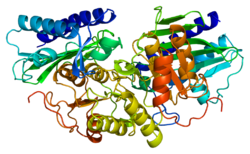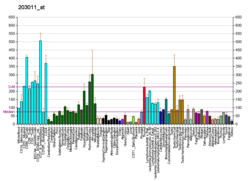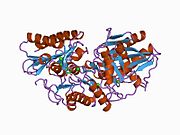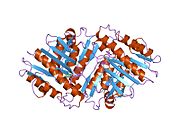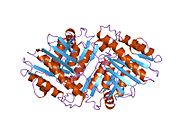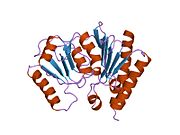
Bone morphogenetic protein 10 (BMP10) is a protein that in humans is encoded by the BMP10 gene.

The gastric inhibitory polypeptide receptor (GIP-R), also known as the glucose-dependent insulinotropic polypeptide receptor, is a protein that in humans is encoded by the GIPR gene.

Leukocyte surface antigen CD53 is a protein that in humans is encoded by the CD53 gene.

Calpain-10 is a protein that in humans is encoded by the CAPN10 gene.

Histone H3.1 is a protein that in humans is encoded by the H3C2 gene.

G-protein coupled receptor 4 is a protein that in humans is encoded by the GPR4 gene.

Probable G-protein coupled receptor 78 is a protein that in humans is encoded by the GPR78 gene.

The enzyme Inositol phosphate-phosphatase is of the phosphodiesterase family of enzymes. It is involved in the phosphophatidylinositol signaling pathway, which affects a wide array of cell functions, including but not limited to, cell growth, apoptosis, secretion, and information processing. Inhibition of inositol monophosphatase may be key in the action of lithium in treating bipolar disorder, specifically manic depression.

Glucosidase 2 subunit beta is an enzyme that in humans is encoded by the PRKCSH gene.

Regulator of G-protein signaling 3 is a protein that in humans is encoded by the RGS3 gene.

DnaJ homolog subfamily B member 6 is a protein that in humans is encoded by the DNAJB6 gene.

Chloride channel 7 alpha subunit also known as H+/Cl− exchange transporter 7 is a protein that in humans is encoded by the CLCN7 gene. In melanocytic cells this gene is regulated by the Microphthalmia-associated transcription factor.

Homeobox protein DLX-4 is a protein that in humans is encoded by the DLX4 gene.

60 kDa SS-A/Ro ribonucleoprotein is a protein that in humans is encoded by the TROVE2 gene.

Cytosolic phospholipase A2 gamma is an enzyme that in humans is encoded by the PLA2G4C gene.

cAMP-dependent protein kinase catalytic subunit gamma is an enzyme that in humans is encoded by the PRKACG gene.

CMP-N-acetylneuraminate-poly-alpha-2,8-sialyltransferase is an enzyme that in humans is encoded by the ST8SIA4 gene.

Dipeptidyl-peptidase 2 is an enzyme that in humans is encoded by the DPP7 gene.
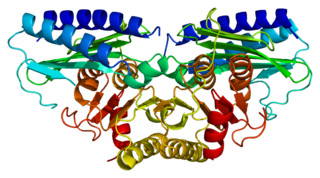
Inositol monophosphatase 2 is a 32 kDa enzyme that in humans is encoded by the IMPA2 gene. IMPA2 dephosphorylates myo-inositol monophosphate to myo-inositol.

Calbindin 1 is a protein that in humans is encoded by the CALB1 gene. It belongs to the calbindin family of calcium-binding proteins, along with calretinin (CALB2).
